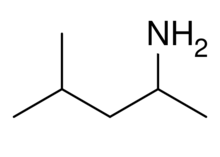1,3-Dimethylbutylamine
(2S )-DMBA
(2R )-DMBA
Names
Preferred IUPAC name
Other names
(4-Methylpentan-2-yl)amine
Identifiers
ChemSpider
UNII
InChI=1S/C6H15N/c1-5(2)4-6(3)7/h5-6H,4,7H2,1-3H3
Key: UNBMPKNTYKDYCG-UHFFFAOYSA-N
InChI=1/C6H15N/c1-5(2)4-6(3)7/h5-6H,4,7H2,1-3H3
Key: UNBMPKNTYKDYCG-UHFFFAOYAT
Properties
C 6 H 15 N
Molar mass
−1
Density
0.717 g/mL[ 1]
Boiling point
108–110 °C (226–230 °F; 381–383 K)[ 1]
Hazards
NFPA 704
Except where otherwise noted, data are given for materials in their
standard state (at 25 °C [77 °F], 100 kPa).
Infobox references
Tracking categories (test):
1,3-Dimethylbutylamine (1,3-DMBA , dimethylbutylamine , DMBA , 4-amino-2-methylpentane , or AMP ), is a stimulant drug structurally related to methylhexanamine where a butyl group replaces the pentyl group . The compound is an aliphatic amine.
The hydrochloride and citrate salts of DMBA has been identified as unapproved ingredients in some over-the-counter dietary supplements,[ 2] [ 3] [ 4] [ 5] [ 6] [ 7]
There are no known human safety studies on DMBA and its health effects are entirely unknown.[ 2] [ 3] [ 8]
References
↑ 1.0 1.1 "1,3-Dimethylbutylamine" . Sigma-Aldrich . http://www.sigmaaldrich.com/catalog/product/aldrich/126411 . ↑ 2.0 2.1 Cohen, Pieter A.; Travis, John C.; Venhuis, Bastiaan J. (2015). "A synthetic stimulant never tested in humans, 1,3-dimethylbutylamine (DMBA), is identified in multiple dietary supplements". Drug Testing and Analysis 7 (1): 83–7. doi :10.1002/dta.1735 . PMID 25293509 . ↑ 3.0 3.1 "Unapproved Synthetic Stimulant "DMBA" Found in Multiple Dietary Supplements" . NSF International. http://www.nsf.org/newsroom/unapproved-synthetic-stimulant-dmba-found-in-multiple-dietary-supplements/ . ↑ "FDA Warns 14 Sports Supplement Companies Of Illegal DMBA (AMP Citrate)" . Forbes . https://www.forbes.com/sites/davidkroll/2015/05/06/fda-warns-14-sports-supplement-companies-of-illegal-dmba-amp-citrate/ . ↑ "Stimulant Potentially Dangerous to Health, FDA Warns" . U.S. Food and Drug Administration. April 11, 2013. https://www.fda.gov/ForConsumers/ConsumerUpdates/ucm347270.htm . Retrieved March 10, 2015 . ↑ "DMBA in Dietary Supplements" . Food and Drug Administration . https://www.fda.gov/Food/DietarySupplements/QADietarySupplements/ucm444719.htm . ↑ Cohen, Pieter A.; Wen, Anita; Gerona, Roy (1 December 2018). "Prohibited Stimulants in Dietary Supplements After Enforcement Action by the US Food and Drug Administration" . JAMA Internal Medicine 178 (12): 1721–1723. doi :10.1001/jamainternmed.2018.4846 . PMID 30422217 . ↑ "Revealing the hidden dangers of dietary supplements" . Science . 20 August 2015. doi :10.1126/science.aad1651 . https://www.science.org/content/article/feature-revealing-hidden-dangers-dietary-supplements .
Adamantanes Adenosine antagonists Alkylamines Ampakines Arylcyclohexylamines Benzazepines Cholinergics Convulsants Eugeroics Oxazolines Phenethylamines
1-(4-Methylphenyl)-2-aminobutane 1-Methylamino-1-(3,4-methylenedioxyphenyl)propane 2-Fuoroamphetamine 2-Fuoromethamphetamine 2-OH-PEA 2-Phenyl-3-aminobutane 2,3-MDA 3-Fuoroamphetamine 3-Fluoroethamphetamine 3-Fluoromethcathinone 3-Methoxyamphetamine 3-Methylamphetamine 3,4-DMMC 4-BMC 4-CMC 4-Fluoroamphetamine 4-Fluoromethamphetamine 4-MA 4-Methylbuphedrone 4-Methylcathinone 4-MEAP 4-MMA 4-Methylpentedrone 4-MTA 6-FNE AL-1095 Alfetamine a-Ethylphenethylamine Amfecloral Amfepentorex Amfepramone Amidephrine 2-Amino-1,2-dihydronaphthalene 2-Aminoindane 5-(2-Aminopropyl)indole 2-Aminotetralin Acridorex Amphetamine (Dextroamphetamine , Levoamphetamine )Amphetaminil Arbutamine β-Methylphenethylamine β-Phenylmethamphetamine Benfluorex Benzedrone Benzphetamine BDB BOH 3-Benzhydrylmorpholine BPAP Buphedrone Bupropion Butylone Camfetamine Cathine Cathinone Chlorphentermine Cilobamine Cinnamedrine Clenbuterol Clobenzorex Cloforex Clortermine Cypenamine D -DeprenylDenopamine Dimethoxyamphetamine Dimethylamphetamine Dimethylcathinone Dobutamine DOPA (Dextrodopa , Levodopa )Dopamine Dopexamine Droxidopa EBDB Ephedrine Epinephrine Epinine Etafedrine Ethcathinone Ethylnorepinephrine Ethylone Etilamfetamine Etilefrine Famprofazone Fencamfamin Fencamine Fenethylline Fenfluramine (Dexfenfluramine , Levofenfluramine )Fenproporex Feprosidnine Flephedrone Fludorex Formetorex Furfenorex Gepefrine Hexapradol Hexedrone HMMA Hordenine 4-Hydroxyamphetamine 5-Iodo-2-aminoindane Ibopamine Indanylamphetamine Iofetamine Isoetarine Isoethcathinone Isoprenaline L -DeprenylLefetamine Lisdexamfetamine Lophophine MBDB MDA (tenamfetamine) MDBU MDEA MDMA (midomafetamine) MDMPEA MDOH MDPR MDPEA Mefenorex Mephedrone Mephentermine Metanephrine Metaraminol Mesocarb Methamphetamine (Dextromethamphetamine , Levomethamphetamine )Methoxamine Methoxyphenamine MMA Methcathinone Methedrone Methoxyphenamine Methylenedioxycathinone Methylone Mexedrone MMDA MMDMA MMMA Morforex N,alpha-Diethylphenylethylamine N-Ethylbuphedrone N-Ethylhexedrone N,N-Dimethylphenethylamine Naphthylamphetamine Nisoxetine Norepinephrine Norfenefrine Norfenfluramine Normetanephrine L -NorpseudoephedrineOctopamine (drug) Orciprenaline Ortetamine Oxifentorex Oxilofrine PBA PCA PCMA PHA Pentorex Pentedrone Pentylone Phenatine Phenpromethamine Phentermine Phenylalanine Phenylephrine Phenylpropanolamine Pholedrine PIA PMA PMEA PMMA PPAP Phthalimidopropiophenone Prenylamine Propylamphetamine Pseudoephedrine Ropinirole Salbutamol (Levosalbutamol )Sibutramine Solriamfetol Synephrine Theodrenaline Tiflorex Tranylcypromine Tyramine Tyrosine Xylopropamine Zylofuramine Phenylmorpholines Piperazines Piperidines Pyrrolidines Racetams Tropanes Tryptamines Others
Original source: https://en.wikipedia.org/wiki/1,3-Dimethylbutylamine. Read more





